Similar presentations:
Mechanics. Key definitions
1. Mechanics
Physics. The Main CourseMECHANICS
2. Key definitions
KEY DEFINITIONSMechanics - part of physics that studies the
laws of mechanical motion and causes which
change the movement.
Mechanical movement - change in the relative
positions of the bodies, or parts of them in the
space over time.
3. Types of mechanics
TYPES OF MECHANICSClassical
Mechanics (GalileyNewton)
Learning the laws of
motion
macroscopic bodies,
which velocities are
small
compared with the
rate
light in vacuum.
v / c << 1
Relativistic studying the laws of
motion
macroscopic bodies with
speeds comparable to c.
Based on the SRT.
Quantum Learning the laws of
motion
macroscopic bodies
(Individual atoms and
elementary particles)
4. Kinematics, Dynamics, Statics
KINEMATICS, DYNAMICS, STATICSKinematics (from the Greek word kinema motion) - the section of mechanics that studies
the geometric properties of the motion of
bodies without taking into account their weight
and acting on them forces.
Dynamics (from the Greek dynamis - force) is
studying the motion of bodies in connection
with the reasons that cause this movement.
5. Kinematics, Dynamics, Statics
KINEMATICS, DYNAMICS, STATICSStatics (from the Greek statike - balance) is
studying the conditions of equilibrium of
bodies.
Since the balance - is a special case of motion,
the laws of statics are a natural consequence
of the laws of dynamics and in this course is
not taught.
6. Models in Mechanics
MODELS IN MECHANICSMaterial - body size, shape and
point of the internal structure which in this problem can be ignored
Absolutely solid - body, which in any
conditions of the body can not be deformed and under all
circumstances the distance between two points of the body
It remains constant
Absolutely elastic - body, the deformation of which
body obeys Hooke's law, and after
termination of the external force takes its initial size and shape
7. System and body of the countdown
SYSTEM AND BODY OF THE COUNTDOWNEvery motion is relative, so it is necessary to
describe the motion conditions on any other
body will be counted from the movement of the
body. Selected for this purpose body called the
body of the countdown.
In practice, to describe the motion necessary to
communicate with the body of the countdown
coordinate system (Cartesian, spherical,
cylindrical, etc.).
8. reference system
REFERENCE SYSTEMReference system - a set of coordinates and
hours related to the body with respect to which
the motion is studied.
Body movements, like matter, can not in
general be out of time and space. Matter,
space and time are inextricably linked to each
other (no space without matter and time, and
vice versa).
9. Kinematics of a material point
KINEMATICS OF A MATERIAL POINTThe position of point A in the space can be
defined by the radius vector drawn from the
reference point O or the origin
10. displacement, path
DISPLACEMENT, PATHWhen moving the point A from point 1 to point
2 of its radius vector changes in magnitude and
direction, ie, It depends on the time t.
The locus of all points is called a trajectory
point.
The length of the path is the path Δs. If the
point moves in a straight line, then the
increment is the path Δs.
11. velocity
VELOCITYThe average velocity vector is defined as the ratio of the displacement
vector by the time Δt, for that this movement happened
Vector
coincides with
direction of the
vector
12. Instantaneous speed
INSTANTANEOUS SPEEDWhen Δt =0 Δ - an infinitely small part of
trajectory
ΔS = Δr movement coincides with the
trajectory) In this case, the instantaneous
velocity can be expressed by a scalar value the path:
13. Instantaneous speed
INSTANTANEOUS SPEED14. Acceleration. The normal and tangential acceleration
ACCELERATION. THE NORMAL AND TANGENTIALACCELERATION
In the case of an arbitrary speed does not
remain constant motion. The speed rate of
change in magnitude and direction of
acceleration are characterized
15. Acceleration
ACCELERATIONWe introduce the unit vector associated with point 1, and directed at a tangent to the
trajectory of the point 1 (vectors and at 1 match).Then we can write:
Where - the magnitude of the velocity.
16. Acceleration
ACCELERATIONWe find the overall acceleration (a derivative)
17. Tangential and normal acceleration
TANGENTIAL AND NORMAL ACCELERATION18. Kinematics of rotational motion
KINEMATICS OF ROTATIONAL MOTIONThe motion of a rigid body in which the two
points O and O 'are fixed, called the rotational
motion around a fixed axis, and the fixed line
OO' is called the axis of rotation.
19. Angular velocity
ANGULAR VELOCITYIt is the vector angular velocity is numerically equal to the first
derivative of the angle in time and directed along the rotation
axis direction (and always in the same direction).
20. Contact the linear and angular velocity
CONTACT THE LINEAR AND ANGULAR VELOCITYLet - linear velocity of the point M.
During the time interval dt the point M passes
the way at the same time
(Central angle). Then,
21. The concepts of rotational motion
THE CONCEPTS OF ROTATIONAL MOTIONPeriod T - period of time during which the body makes a
complete revolution ( turn on the corner)
The frequency ν - number of revolutions of
the body in 1 second
22. angular acceleration
ANGULAR ACCELERATIONWe express the normal and tangential acceleration of M
through the angular velocity and angular acceleration
23. The connection between the linear and angular values the rotational movement:
THE CONNECTION BETWEEN THE LINEAR ANDANGULAR VALUES THE ROTATIONAL MOVEMENT:
24. The connection between the linear and angular values the rotational movement:
THE CONNECTION BETWEEN THE LINEAR ANDANGULAR VALUES THE ROTATIONAL MOVEMENT:
25. dynamics
DYNAMICSDynamics (from the Greek dynamis - force) is
studying the motion of bodies in connection
with the reasons that cause this movement.
26. Newton's first law. Inertial systems
NEWTON'S FIRST LAW. INERTIAL SYSTEMSThe so-called classical or Newtonian mechanics
are three laws of dynamics, formulated by
Newton in 1687. These laws play a crucial role
in the mechanics and are (like all the laws of
physics) a generalization of the results of vast
human experience.
27. Newton's First Law
NEWTON'S FIRST LAWЕvery material point stores the state of rest or
uniform rectilinear motion until such time as
the effects of other bodies will not force her to
change this state.
28. Newton's First Law
NEWTON'S FIRST LAWBoth of these states are similar in that the
acceleration body is zero. Therefore, the first
law of the formulation can be given as follows:
speed of any body remains constant (in
particular, zero), while the impact on the body
by other bodies it will not cause change.
29. Newton's First Law
NEWTON'S FIRST LAWThe desire to preserve the body state of rest or
uniform rectilinear motion is called inertia.
Therefore, Newton's first law is called the law of
inertia.
30. inertia
INERTIAInertial frame of reference is such a frame of
reference with respect to which a material
point, free from external influences, either at
rest or moving uniformly (ie, at a constant
speed).
Thus, Newton's first law asserts the existence
of inertial reference systems.
31. The mass and momentum of the body
THE MASS AND MOMENTUM OF THE BODYExposure to this body by other bodies causes a change
in its speed, i.e. аccording to this body acceleration.
Experience shows that the same effect according to
different bodies of different sizes acceleration. Every
body resists attempts to change its state of motion. This
property of bodies, as we have said, is called inertia
(this follows from Newton's first law).
The measure of inertia of a body is a quantity called the
mass.
To determine the mass of a body, you need to compare
it with the weight taken as the standard body weight (or
compare it with already known body mass).
32. The mass and momentum of the body
THE MASS AND MOMENTUM OF THE BODYMass - the value of the additive (body weight
equal to the sum of the masses of parts that
make up this body).
Systems, interacting only with each other, said
to be closed.
Consider a closed system of two bodies of
masses and be faced these two bodies
33. The mass and momentum of the body
THE MASS AND MOMENTUM OF THE BODYExperience shows that the speeds have the opposite
directions which are different in sign but equal in absolute
value
34. The mass and momentum of the body
THE MASS AND MOMENTUM OF THE BODYTaking into account the direction of the
velocity, we can write:
35. momentum of the body
MOMENTUM OF THE BODY36. Newton's Second Law
NEWTON'S SECOND LAWthe rate of change of momentum of a body is
equal to the force acting on it.
From this we can conclude that the change of
the momentum of a body is equal to the
momentum forces.
37. Newton's Third Law
NEWTON'S THIRD LAWInteracting bodies act on each other with the same magnitude but opposite
in direction forces:
38. Every action causes an equal largest opposition
EVERY ACTION CAUSES AN EQUAL LARGESTOPPOSITION
39. The law of conservation of momentum
THE LAW OF CONSERVATION OF MOMENTUMThe mechanical system is called a closed (or isolated), if it is not acted upon
by external forces, ie, it does not interact with external bodies.
Strictly speaking, each real system of bodies is never closed because
subject to a minimum the effects of gravitational forces. However, if the
internal forces is much more external, that such a system can be considered
closed (for example - the solar system).
For a closed system resultant vector of the external forces it is identically
equal to zero:
40. The law of conservation of momentum
THE LAW OF CONSERVATION OF MOMENTUMIn all the processes occurring in closed
systems, the speed of the center of mass
remains unchanged.
The law of conservation of momentum is one
of the fundamental laws of nature. He was
received as a consequence of Newton's laws,
but it is also valid for the microparticles and
to relativistic speeds
41. Gravity and the weight
GRAVITY AND THE WEIGHTOne of the fundamental forces - gravity force is manifested on Earth in the form of
gravitational force - the force with which all bodies are attracted to the Earth.
Near the Earth's surface all bodies fall with the same acceleration - the acceleration
of gravity g, (remember school experience - "Newton's tube"). It follows that in the
frame of reference associated with the earth, to every body the force of gravity
acceleration of gravity
gravity
42. Gravity and the weight
GRAVITY AND THE WEIGHTIf the body is hung or put it on a support, the force of
gravity is balanced by the force, which is called the
reaction support or suspension
43. frictional forces
FRICTIONAL FORCESFriction is divided into external and internal.
External friction occurs when the relative
movement of the two contacting solids (sliding
friction or static friction).
Internal friction occurs upon relative movement
of parts of one and the same solid body (e.g.,
liquid or gas).
44. frictional forces
FRICTIONAL FORCESFrictional forces - tangential forces arising in
the contact surfaces of bodies and prevent
their relative movement
friction coefficient
45. frictional forces
FRICTIONAL FORCES46. Inclined plane
INCLINED PLANE47. ENERGY. work. CONSERVATION LAWS
ENERGY. WORK. CONSERVATION LAWS48. Potential energy
POTENTIAL ENERGYIf the system of material bodies are
conservative forces, it is possible to introduce
the concept of potential energy.
Work done by conservative forces when
changing the system configuration, that is,
when the position of the bodies relative to the
frame, regardless of whether this change was
implemented
49. The formula for the potential energy
THE FORMULA FOR THE POTENTIAL ENERGY50. Kinetic energy
KINETIC ENERGYThe function of the system status, which is
determined only by the speed of its motion is called
kinetic energy.
The kinetic energy of the system is a function
of the state of motion of the system.
51. Units of energy measurement
UNITS OF ENERGY MEASUREMENTEnergy is measured in SI units in the force
works on the distance in newtons per meter
(joules)
52. Contact of the kinetic energy with momentum p.
CONTACT OF THE KINETIC ENERGY WITHMOMENTUM P.
53. Contact of the kinetic energy with the work.
CONTACT OF THE KINETIC ENERGY WITH THEWORK.
If a constant force acts on the body, it will move
in the direction of the force. Then, the unit
operation of the body movement of v. 1 to Vol.
2, is the product of force F to displacement dr
54. Contact of the kinetic energy with the work.
CONTACT OF THE KINETIC ENERGY WITH THEWORK.
Consequently, the work of the force applied to
the body in the path r is numerically equal to
the change in kinetic energy of the body:
kinetic energy is equal to the variation dK of
external forces:
Work, as well as the kinetic energy is
measured in joules.
55. power
POWERThe rate of doing work (energy transfer) is called
power.
Power has the work done per unit of time.
instantaneous power
average power
Power Unit -Vatt
56. Conservative and non-conservative forces
CONSERVATIVE AND NON-CONSERVATIVEFORCES
Also contact interactions observed interaction
between bodies, distant from each other. This
interaction takes place through physical fields
(a special form of matter).
Each body creates around itself a field, which
manifests itself is the impact on other bodies.
57. Conservative and non-conservative forces
CONSERVATIVE AND NON-CONSERVATIVEFORCES
Force, whose work does not depend on the way in
which the moving body, and depends on the initial and
final position of the body are called conservative.
58. Conservative and non-conservative forces
CONSERVATIVE AND NON-CONSERVATIVEFORCES
Conservative forces: gravity, electrostatic
forces, the forces of the central stationary field.
Non-conservative forces: the force of friction,
the forces of the vortex electric field.
Conservative system - such inner strength that
only conservative external - conservative and
stationary.
59. The relationship between potential energy and force
THE RELATIONSHIP BETWEEN POTENTIALENERGY AND FORCE
The space in which there are conservative
forces, called the potential field.
Each point corresponds to a potential field
strength value
acting on the body, and a value of the potential
energy U.
60. The law of conservation of mechanical energy
THE LAW OF CONSERVATION OF MECHANICALENERGY
The law of conservation brings together the
results we obtained earlier.
In the forties of the nineteenth century works of
R. Mayer, Helmholtz and John. Joule (all at
different times and independently of each
other) has been proved by the law of
conservation and transformation of energy.
61. The law of conservation of mechanical energy
THE LAW OF CONSERVATION OF MECHANICALENERGY
For a conservative system of particles the total
energy of the system:
For the law of conservation of mechanical
energy is: total mechanical energyConservatory-conservative system of material
points remains constant.
62. For a closed system
FOR A CLOSED SYSTEMthe total mechanical energy of a closed
system of material points between which
there are only conservative forces, remains
constant.
63. Collisions
COLLISIONS64. Absolutely elastic central collision
ABSOLUTELY ELASTIC CENTRAL COLLISIONWith absolutely elastic collision - this is a blow,
in which there is no conversion of mechanical
energy into other forms of energy.
65. Inelastic collision
INELASTIC COLLISIONInelastic collision - a collision of two bodies, in
which the body together and move forward as
one.
66. Dynamics of rotational motion of the SOLID body
DYNAMICS OF ROTATIONAL MOTION OFTHE SOLID BODY
67. Dynamics of rotational motion of a solid body Relatived to the axis
DYNAMICS OF ROTATIONAL MOTION OF A SOLIDBODY RELATIVED TO THE AXIS
68. MoMENT OF INERTIA
MOMENT OF INERTIA69. the main body dynamics equation of rotating around a fixed axis
THE MAIN BODY DYNAMICS EQUATION OFROTATING AROUND A FIXED AXIS
70. auxiliary equationS
AUXILIARY EQUATIONS71. Steiner's theorem
STEINER'S THEOREMMoment of inertia
with respect to any axis of rotation is equal to
the time of his inertia
relative to the parallel axis passing through
the mass center C of body weight plus the
product of square of the distance between
the axles.
72. The kinetic energy of a rotating body
THE KINETIC ENERGY OF A ROTATING BODYThe kinetic energy - the value of the additive, so
that the kinetic energy of a body moving in an
arbitrary manner, is the sum of the kinetic
energies of all n material points by which this
body can mentally break:
73. translation and rotational motion
TRANSLATION AND ROTATIONAL MOTIONThe total kinetic energy of the body:
74. relativistic mechanics
RELATIVISTIC MECHANICS75. Galileo's principle of relativity.
GALILEO'S PRINCIPLE OF RELATIVITY.In describing the mechanics was assumed that all the velocity
of the body is much less than the speed of light. The reason for
this is that Newton's mechanics (classical) is incorrect, at
speeds of bodies close to the speed of light
The correct theory for this case is called
relativistic mechanics or the special theory of
relativity
76. Galilean transformation
GALILEAN TRANSFORMATIONAccording to classical mechanics: mechanical
phenomena occur equally in the two reference
frames moving uniformly in a straight line
relative to each other.
77. Galilean transformation
GALILEAN TRANSFORMATION78. Interval of the space
INTERVAL OF THE SPACE79. Galilean transformation
GALILEAN TRANSFORMATIONMoments of time in different reference frames
coincide up to a constant value determined by
the procedure of clock synchronization
80. Galileo's principle of relativity.
GALILEO'S PRINCIPLE OF RELATIVITY.The laws of nature that determine the change
in the state of motion of mechanical systems
do not depend on which of the two inertial
reference systems they belong
81. Einstein's principle of relativity
EINSTEIN'S PRINCIPLE OF RELATIVITYIn 1905 in the journal "Annals of Physics" was
published a famous article by A. Einstein "On
the Electrodynamics of Moving Bodies", in
which the special theory of relativity (SRT) was
presented.
Then there was a lot of articles and books
explaining, clarifying, interpreting this theory.
82. two of Einstein's postulate
TWO OF EINSTEIN'S POSTULATE83. two of Einstein's postulate
TWO OF EINSTEIN'S POSTULATE1. All laws of nature are the same in all inertial
reference systems.
2. The speed of light in a vacuum is the same
in all inertial reference systems, and does not
depend on the velocity of the source and the
light receiver.
84. Lorentz Transformations
LORENTZ TRANSFORMATIONSFormula conversion in the transition from one
inertial system to another, taking into account
Einstein's postulates suggested Lorenz in 1904
85. Lorentz Transformations
LORENTZ TRANSFORMATIONSLorenz established a link between the
coordinates and time of the event in the frame
k and k 'based on the postulates of SRT
Thus, at high speeds comparable to the speed
of light received Lorenz
86. Lorentz Transformations
LORENTZ TRANSFORMATIONS87. Fourth dimension
FOURTH DIMENSIONThe true physical meaning of Lorentz
transformations was first established in 1905
by Einstein in SRT. In the theory of relativity,
time is sometimes called the fourth dimension.
More precisely, ct value of having the same
dimension as x, y, z behaves as a fourth spatial
coordinate. In the theory of relativity ct and x
manifest themselves from a mathematical
point of view in a similar way.
88. Fourth dimension
FOURTH DIMENSION89. Fourth dimension
FOURTH DIMENSIONAt low speeds or, at infinite speed bye-injury
theory of long-range interactions), the Lorentz
transformations turn into Galileo's
transformation (matching principle).
90. Conclusions of the Lorentz transformations
CONCLUSIONS OF THE LORENTZTRANSFORMATIONS
1)Lorentz transformations demonstrate the
inextricable link spatial and temporal
properties of our world (the world of fourdimensional).
2)On the basis of the Lorentz transformation
can be described by the relativity of
simultaneity.
3) It is necessary to introduce a relativistic
velocity addition law.
91. Lorentz contraction length ( length of bodies in different frames of reference)
LORENTZ CONTRACTION LENGTH( LENGTH OF BODIES IN DIFFERENT FRAMES OF
REFERENCE)
moving body length shorter than the resting
92. Slowing down time (Duration of the event in different frames of reference)
SLOWING DOWN TIME(DURATION OF THE EVENT IN DIFFERENT
FRAMES OF REFERENCE)
The proper time - lowest (moving clocks run
slower resting)
93. Mass, momentum and energy in relativistic mechanics
MASS, MOMENTUM AND ENERGY INRELATIVISTIC MECHANICS
94. The relativistic increase in mass of the particles of matter
THE RELATIVISTIC INCREASE IN MASS OF THEPARTICLES OF MATTER
95. The relativistic expression for momentum
THE RELATIVISTIC EXPRESSION FORMOMENTUM
96. The relativistic expression for the energy
THE RELATIVISTIC EXPRESSION FOR THEENERGY
97. Molecular-kinetic theory
MOLECULAR-KINETIC THEORY98. the effect of steam
THE EFFECT OF STEAMJet Propulsion ball mounted on a tubular racks, by the reaction
provided by the escaping steam, it has been demonstrated
2000 years ago Hero of Alexandria.
99. Basic concepts and definitions of molecular Physics and thermodynamics
BASIC CONCEPTS AND DEFINITIONS OFMOLECULAR PHYSICS AND THERMODYNAMICS
The set of bodies making up the macroscopic
system is called thermodynamic system.
The system can be in different states. The
quantities characterizing the system status,
condition called parameters: pressure P, T the
temperature, the volume V, and so on.
Communication between the P, T, V is specific
for each body is called an equation of state.
100. Basic concepts and definitions of molecular Physics and thermodynamics
BASIC CONCEPTS AND DEFINITIONS OFMOLECULAR PHYSICS AND THERMODYNAMICS
Any parameter having a certain value for each
of the equilibrium state is a function of the
system state. The equilibrium system - such a
system, the state parameters which are the
same in all points of the system and does not
change with time (at constant external
conditions). Thus in equilibrium are selected
macroscopic portion of the system.
101. Basic concepts and definitions of molecular Physics and thermodynamics
BASIC CONCEPTS AND DEFINITIONS OFMOLECULAR PHYSICS AND THERMODYNAMICS
The process - the transition from one
equilibrium state to another. Relaxation - the
return of the system to an equilibrium state.
Transit Time - the relaxation time
102. The atomic weight of chemical elements (atomic weight) A
THE ATOMIC WEIGHT OF CHEMICAL ELEMENTS(ATOMIC WEIGHT) A
103. The molecular weight (MW)
THE MOLECULAR WEIGHT (MW)From here you can find a lot of atoms and
molecules in kilograms:
104. Definitions
DEFINITIONSIn thermodynamics, the widely used concept of k-mol, mole,
Avogadro's number and the number of Loschmidt. We give a
definition of these quantities.
Mol - a standardized amount of any substance in gaseous,
liquid or solid state. 1 mol - the number of grams of material
equal to its molecular weight.
105. Number of Avogadro
NUMBER OF AVOGADROIn 1811 Avogadro suggested that the number of particles per
kmol of any substance is constant and equal to the called, in
consequence, the number of Avogadro
Molar mass - the mass of one mole of (μ)
106. number of Loschmidt
NUMBER OF LOSCHMIDTAt the same temperatures and pressures of all the gases
contained in a unit volume of the same number of molecules.
The number of ideal gas molecules contained in 1 m3 under
normal conditions, is called the number Loschmidt:
k = 1,38 · 10(-23) J / K - Boltzmann constant
107. Pressure. The basic equation of molecular-kinetic theory
PRESSURE. THE BASIC EQUATION OFMOLECULAR-KINETIC THEORY
gas pressure - there
consequence of the collision gas
molecules with the walls of the vessel.
108. Pressure
PRESSURE109. the basic equation of molecular-kinetic theory of gases.
THE BASIC EQUATION OF MOLECULAR-KINETICTHEORY OF GASES.
Gas pressure is determined by the average
kinetic energy of the translational motion of
the molecules.
110. Temperature
TEMPERATURER - universal gas constant
111. The basic equation of molecular-kinetic theory-2
THE BASIC EQUATION OF MOLECULAR-KINETICTHEORY-2
112. The probability of the event. The concept of the distribution of the velocity of the gas molecules
THE PROBABILITY OF THE EVENT. THE CONCEPTOF THE DISTRIBUTION OF THE VELOCITY OF THE
GAS MOLECULES
From the standpoint of atomic-molecular
structure of the substance values found in
macroscopic physics, the sense of average
values, which take some of the features from
microscopic variables of the system. Values of
this kind are called statistics. Examples of such
variables are pressure, temperature, density
and others.
113. The probability of the event. The concept of the distribution of the velocity of the gas molecules
THE PROBABILITY OF THE EVENT. THE CONCEPTOF THE DISTRIBUTION OF THE VELOCITY OF THE
GAS MOLECULES
A large number of colliding atoms and
molecules causes important patterns in the
behavior of statistical variables, not peculiar to
individual atoms and molecules. ? These
patterns are called probabilistic or statistical
114. Maxwell distribution function
MAXWELL DISTRIBUTION FUNCTIONSuppose there are n identical molecules in a
state of random thermal motion at a certain
temperature. After each act of collisions
between molecules, their speed changes
randomly.
stationary equilibrium state is
established in the resulting incredibly large
number of collisions, the number of molecules
in a given velocity range is kept constant.
115. Maxwell distribution function
MAXWELL DISTRIBUTION FUNCTION116. the distribution function of the velocity
THE DISTRIBUTION FUNCTION OF THE VELOCITYfunction indicates the share of single
molecules of gas volume, the absolute
velocities are enclosed in a single speed
range, which includes the given speed.
117. The barometric formula
THE BAROMETRIC FORMULAThe atmospheric pressure at a height h due to
the weight of the overlying layers of gas.
118. first law of thermodynamics
FIRST LAW OF THERMODYNAMICS119. first law of thermodynamics
FIRST LAW OF THERMODYNAMICSQ ΔU A
The amount of heat imparted to the body,
goes to increase the internal energy and body
to perform work:
120. first law of thermodynamics
FIRST LAW OF THERMODYNAMICSΔU Q A
the change in internal energy of a body is
equal to the difference between the reported
and the body heat of the produced work of
body
121. Application of the first law of thermodynamics to Izoprocesses of ideal gases
APPLICATION OF THE FIRST LAW OFTHERMODYNAMICS TO IZOPROCESSES OF
IDEAL GASES
Izo - processes in which one of the
thermodynamic parameters remain constant
122. Isothermal process
ISOTHERMAL PROCESSisothermal expansion
Conditions of flow
T const
Q A
Q 0
р
U=
V
0
A 0
123. Isothermal process
ISOTHERMAL PROCESSIsothermal compression
T const
Conditions of flow
p
V
U =0
Q A
Q 0
A 0
124. isochoric heating
ISOCHORIC HEATINGV const
Q U
Q 0
p
2
1
V
U Q
U 0
A 0
125. isochoric cooling
ISOCHORIC COOLINGV const
Q U
Q 0
p
1
U Q
U 0
2
V
A 0
126. Isobar extension and compression
ISOBAR EXTENSION AND COMPRESSIONHomework
p const
127. Adiabatic process
ADIABATIC PROCESSAdiabatic process - a process in which a heat
exchange with the environment.
Q 0
In the case of adiabatic process, the system
does work due to the decrease in internal
energy
A U
128. Homework
HOMEWORKLaws of processes
129. ENTROPY
Entropy S - is the ratio of received-term ortransferred heat to the tempera-D, in which this
process took place.
dQ
dS
T
130. For reversible processes, entropy change:
FOR REVERSIBLE PROCESSES, ENTROPYCHANGE:
ΔS обр 0, т.к.
dQобр
T
0
This expression is called the Clausius
equality.
131. The second law of thermodynamics
THE SECOND LAW OF THERMODYNAMICSIt can not process the only result of which is the
transformation of the entire heat produced by
the heater in an equivalent job (wording Kelvin)
2. There can not be a perpetual motion
machine of the second kind (the wording of the
Thompson-Plank).
3. It can not process the only result of which is
the transfer of energy from a cold body to a hot
(Clausius formulation).
132. THERMAL MACHINES
Circular process, or cycle, called such aprocess, in which the thermodynamic body
returns to its original state.
133. Circular process
CIRCULAR PROCESSCycle perpetrated an ideal gas can be divided
into processes:
extensions (1 - 2)
Compression (2 - 1) of the gas
134. Circular process
CIRCULAR PROCESSCircular processes underlie all heat engines: internal
combustion engines, steam and gas turbines, steam and
refrigeration machines, etc. As a result, a circular process, the
system returns to its original state and, therefore, a complete
change in the internal energy of the gas is equal to zero: dU = 0
Then the first law of thermodynamics for a circular process
Q ΔU A A
135. Circular process
CIRCULAR PROCESSThe process is called reversible If it proceeds in
such a way that after the process, it may be
conducted in the reverse direction through the
same intermediate state, and that the direct
process. After the circular reversible process no
changes in the environment surrounding the
system, will not occur. At the same time a
medium is understood the set of all non-system
bodies with which the system interacts directly.
136. Circular process
CIRCULAR PROCESSThe process is called irreversible, if it takes
place, so that after the end of the system can
not return to its initial state after the previous
intermediate states. It is impossible to carry out
an irreversible cyclic process, to anywhere in
the environment remained unchanged.
137. Heat engines
HEAT ENGINESHeat machine called a batch engine to do work
on account of the resulting heat outside.
138. An ideal heat engine
AN IDEAL HEAT ENGINEThe greatest efficiency of the heater at predetermined
temperatures T1 and T2 of the refrigerator has the heat engine
working fluid which expands and contracts by the Carnot cycle
schedule which consists of two isotherms and two adiabatic
139. Carnot cycle
CARNOT CYCLE140. Carnot cycle
CARNOT CYCLECycle, Carnot studied, is the most economical and is a cyclic
process consisting of two isotherms and two adiabatic
141. Efficiency Carnot Machine
EFFICIENCY CARNOT MACHINEA Q1 Q2
Q2
T2
η
1
1 .
Q1
Q1
Q1
T1
142. Real gases
REAL GASES143. Real gases
REAL GASESEquation Mendeleev - Clapeyron - the simplest, most reliable
and well-known equation of state of an ideal gas.
m
PV RT
μ
Real gases are described by the equation of
state of an ideal gas is only approximate, and
deviations from the ideal behavior become
noticeable at high pressures and low
temperatures, especially when the gas is
close to condensation.
144. Real gases
REAL GASESThe First Amendment to the ideal gas equation of state is
considering its own volume occupied by the molecules of a real
gas. In equation Dupre (1864)
P(V νb) νRT
the constant b takes into account its own
molar volume of molecules.
145. Real gases
REAL GASESAs the temperature decreases the intermolecular
interaction in real gases leads to condensation (fluid
generation). Intermolecular attraction is equivalent to
the existence of some of the gas internal pressure P *
(sometimes called static pressure). Initially P * value
was taken into account in general terms in the
equation Girne (1865)
( P P*)(V νb) νRT
146. Van der Waals equation
VAN DER WAALS EQUATIONVan der Waals gave a functional interpretation
of the internal pressure. According to the model
of Van der Waals attractive forces between
molecules (Van der Waals force) is inversely
proportional to the sixth power of the distance
between them, or a second degree of the
volume occupied by the gas. It is also believed
that the force of attraction added to the
external pressure.
147. Van der Waals equation
VAN DER WAALS EQUATIONWith these considerations in mind an ideal gas equation of
state is transformed into the equation of van der Waals forces:
2
ν a
(V νb) P 2
V
νRT
or for one mole
a
(Vm b) P 2 νRT
Vm
148. Real gases
REAL GASESReal gases - gases whose properties depend
on the molecular interaction. Under normal
conditions, when the average potential energy
of intermolecular interaction is much smaller
than the average kinetic energy of the
molecules, the properties of real and ideal
gases differ slightly. The behavior of these
gases varies sharply at high pressures and low
temperatures where quantum effects begin to
appear.
149. Van der Waals force
VAN DER WAALS FORCEVan der Waals to explain the properties of real
gases and liquids, suggested that at small
distances between molecules are repulsive
forces, which are replaced with increasing
distance attraction forces.
150. Van der Waals force
VAN DER WAALS FORCEIntermolecular interactions-tion are electrical in
nature and consist of attractive forces
(orientation, induction, dispersion) and
repulsive forces.
151. The internal energy of the gas van der Waals
THE INTERNAL ENERGY OF THE GAS VAN DERWAALS
The energy of one mole of a gas van der Waals force is
composed of:
the internal energy of the gas molecules;
the kinetic energy of the thermal motion of the center of mass
of molecules
the potential energy of mutual attraction of molecules
152. Van der Waals force
VAN DER WAALS FORCEThe principal value of the van der Waals
equation is determined by the following factors
1) The equation was derived from the model of
the properties of real gases and liquids, and
not the result of empirical selection function f
(P, V, T), which describes the properties of real
gases;
153. Van der Waals force
VAN DER WAALS FORCE2) The equation for a long time regarded as a
general form of the equation of state of real
gases, on the basis of which it was built many
other equations of state;3) Using the equation
of van der Waals forces were the first to
describe the phenomenon of transfer of gas
into the liquid and analyze critical phenomena.
In this regard, the Van der Waals has an
advantage even before the more accurate
equations in virial form.
154. Joule-Thomson effect
JOULE-THOMSON EFFECTIf the ideal gas adiabatically expands and
performs work at the same time, then it is
cooled, as in this case, the work is done at the
expense of its internal energy.
A similar process, but with a real gas - adiabatic
expansion of a real gas to the commission of
external forces positive work
155. Joule-Thomson effect
JOULE-THOMSON EFFECTJoule-Thomson effect is to change the temperature of
the gas as a result of a slow flow of gas under a
constant pressure drop through the reactor - a local
obstacle to the gas flow, such as a porous membrane
positioned in the flow path.
156. Joule-Thomson effect
JOULE-THOMSON EFFECTJoule-Thomson effect indicates the presence of
gas in the intermolecular forces. Gas performs
external work - subsequent layers of gas
pushed past, and perform work force of the
external pressure, providing a stationary flow of
gas itself. The work of pushing through the
throttle portion of gas volume V1 at a pressure
P1 is P1V1, throttle this portion of gas occupies
a volume V2 and does work P2V2.
157. Liquefaction of gases
LIQUEFACTION OF GASESThe conversion of any gas in the liquid - gas
liquefaction - is possible only at temperatures
below the critical value.
158. Liquefaction of gases
LIQUEFACTION OF GASES1 - cylinder compressor; 2 - cooling fins; 3 regenerator; 4 - head cold; 5 - insulation; 6 cylinder expander.
159. Liquefaction of gases
LIQUEFACTION OF GASES160. electricity
ELECTRICITY161. Nature
NATUREThe first known manifestations of "animal
electricity" were discharges of electric fishes.
The electric catfish was depicted even on
ancient Egyptian tombs, and Galen (130-200
years of our era) recommended
"electrotherapy" with the help of these fishes,
who underwent medical practice at gladiatorial
battles in Ancient Rome.
162. History
HISTORYIn the years 1746-54. Franklin explained the action
of the Leyden jar, built the first flat capacitor
consisting of two parallel metal plates separated
by a glass layer, invented a lightning rod in 1750,
proved in 1753 the electrical nature of lightning
(experience with a kite) and the identity of
terrestrial and atmospheric electricity. In 1750, he
developed a theory of electrical phenomena - the
so-called "unitary theory", according to which
electricity represents a special thin liquid, piercing
all the bodies
163. History
HISTORYThe Leiden Bank was invented in 1745 by an independent Dutch professor Peter Van
Mushenbrock (1692-1761) and German prelate Ewald George von Kleist. The
dielectric in this condenser was the glass of the vessel, and the plates were water in
the vessel and the palm of the experimenter, which held the vessel. The output of
the inner lining was a metallic conductor, passed into a vessel and immersed in
water. In 1746, various modifications of the Leyden jar appeared. The Leiden bank
allowed to store and store relatively large charges, of the order of a microcube.
164. electric charge
ELECTRIC CHARGEElectric charges do not exist by themselves, but are internal properties of
elementary particles - electrons, protons, etc.
Experienced in 1914, the American physicist R. Milliken showed that
Electric charge is discrete.
The charge q of any body is an integral multiple of the elementary electric
charge: q = n × e.
e 1,6 10
19
Кл
165. Law of conservation of charge
LAW OF CONSERVATION OF CHARGEThe law of conservation of charge is one of the
fundamental laws of nature, formulated in 1747 by B.
Franklin and confirmed in 1843 by M. Faraday: the
algebraic sum of charges arising in any electric
process on all bodies participating in the process is
zero.
The total electric charge of a closed system does not
change
166. Electric charge
ELECTRIC CHARGEElectrostatics is a section that studies static
(immobile) charges and associated electric
fields.
167. Laws
LAWS168. The Coulomb Law
THE COULOMB LAWA great contribution to the study of phenomena
of electrostatics was made by the famous
French scientist
S. Coulomb.
In 1785, he experimentally established the law
of interaction of fixed point electric charges.
169. Interaction of electric charges in a vacuum.
INTERACTION OF ELECTRIC CHARGES IN AVACUUM.
A point charge (q) is a charged body whose
dimensions are negligibly small in comparison
with the distance to other charged bodies with
which it interacts.
170. The Coulomb Law
THE COULOMB LAWThe force of interaction of point charges in a
vacuum is proportional to the value of the
charges and inversely proportional to the
square of the distance between them.
q1q2
F k0 2
r
171. coefficient
COEFFICIENTWhere ε0 is the electric constant;
4p here express the spherical symmetry of
Coulomb's law.
Н м
k0
9 10
2
4 0
Кл
1
9
2
172. Electrostatic field strength
ELECTROSTATIC FIELD STRENGTHAround the charge there is always an electric field,
the main property of which is that any other
charge placed in this field is acted upon by force.
Electric and magnetic fields are a special case of a
more general - electromagnetic field (EMF).
They can breed each other, turn into each other.
If the charges do not move, then the magnetic
field does not arise.
173. Electrostatic field strength
ELECTROSTATIC FIELD STRENGTHThe force characteristic of the field created by the charge q is
the ratio of the force acting on the test charge q 'placed at a
given point of the field to the value of this charge, called the
electrostatic field strength, i.e.
F
q
E
2
q' 4 0 r
174. Field lines of electrostatic field
FIELD LINES OF ELECTROSTATIC FIELDThe Ostrogradsky-Gauss theorem, which we
shall prove and discuss later, establishes the
connection between electric charges and the
electric field. It is a more general and more
elegant formulation of Coulomb's law.
175. Lines of force
LINES OF FORCELines of force are lines tangent to which at any
point of the field coincides with the direction of
the tension vector
176. The Ostrogradsky-Gauss theorem
THE OSTROGRADSKY-GAUSS THEOREMSo, by definition, the flux of the electric field
strength vector is equal to the number of
tension lines crossing the surface S.
177. The Ostrogradsky-Gauss theorem
THE OSTROGRADSKY-GAUSS THEOREMФЕ
q
Е dS
n
S
ε0
The flux of the electric field strength vector through a closed surface in a
vacuum is equal to the algebraic sum of all charges located inside the surface
divided by ε0.
1
ФE dV
ε0 V
178. potential
POTENTIALThe work of electrostatic forces does not
depend on the shape of the path, but only on
the coordinates of the initial and final points of
displacement. Consequently, the field strengths
are conservative, and the field itself is
potentially.
179. potential difference
POTENTIAL DIFFERENCEW
φ .
q'
From this expression it follows that the
potential is numerically equal to the potential
energy that a unit positive charge possesses at
a given point of the field.
180. DIELECTRICS IN THE ELECTROSTATIC FIELD
In an ideal dielectric, free charges, that is,capable of moving over significant distances
(exceeding the distances between atoms), no.
But this does not mean that a dielectric placed
in an electrostatic field does not react to it, that
nothing happens in it.
181. DIELECTRICS IN THE ELECTROSTATIC FIELD
The displacement of electrical charges of a substance underthe action of an electric field is called polarization.
The ability to polarize is the main property of dielectrics.
182. DIELECTRICS IN THE ELECTROSTATIC FIELD
Inside the dielectric, the electric charges of the dipoles canceleach other out. But on the outer surfaces of the dielectric,
adjacent to the electrodes, charges of the opposite sign appear
(surface-bound charges).
183. Different kinds of dielectrics
DIFFERENT KINDS OF DIELECTRICSIn 1920, spontaneous (spontaneous) polarization
was discovered.
The whole group of substances was called
ferroelectrics (or ferroelectrics).
All ferroelectrics exhibit a sharp anisotropy of
properties (ferroelectric properties can be
observed only along one of the crystal axes). In
isotropic dielectrics, the polarization of all
molecules is the same, for anisotropic ones polarization, and consequently the polarization
vector in different directions is different.
184. Different kinds of dielectrics
DIFFERENT KINDS OF DIELECTRICSAmong dielectrics, there are substances called
electret-dielectrics, which preserve the
polarized state for a long time after removal of
the external electrostatic field (analogues of
permanent magnets).
185. Different kinds of dielectrics
DIFFERENT KINDS OF DIELECTRICSSome dielectrics are polarized not only under
the action of the electric field, but also under
the action of mechanical deformation. This
phenomenon is called the piezoelectric effect.
The phenomenon was discovered by the
brothers Pierre and Jacques Curie in 1880.
186. Different kinds of dielectrics
DIFFERENT KINDS OF DIELECTRICSPyroelectricity - the appearance of electrical
charges on the surface of some crystals when
they are heated or cooled.
When heated, one end of the dielectric is
charged positively, and when cooled, it is also
negative.
The appearance of charges is associated with a
change in the existing polarization as the
temperature of the crystals changes.
187. Electric current in gases. Gas discharges and their applications
ELECTRIC CURRENT IN GASES. GASDISCHARGES AND THEIR APPLICATIONS
188. The phenomenon of ionization and recombination in gases
THE PHENOMENON OF IONIZATION ANDRECOMBINATION IN GASES
The ionization process consists in the fact that under the
action of high temperature or some rays the molecules of
the gas lose electrons and thereby turn into positive ions.
The current in gases is a counterflow of ions and free
electrons.
Simultaneously with the ionization process, there is a
reverse process of recombination (otherwise - molization).
Recombination is a neutralization when different ions are
encountered, or a reunion of an ion and an electron into a
neutral molecule (atom).
The factors under the action of which ionization occurs in a
gas are called external ionizers, and the conductivity that
occurs here is called a non-self-sustaining conductivity.
189. Self-contained gas discharge
SELF-CONTAINED GAS DISCHARGEAn independent discharge is a gas discharge in
which the current carriers arise as a result of
those processes in the gas that are due to the
voltage applied to the gas.
That is, this discharge continues after the
ionizer stops.
190. Self-contained gas discharge
SELF-CONTAINED GAS DISCHARGEWhen the interelectrode gap is covered by a
completely conducting gas-discharge plasma,
its breakdown occurs.
The voltage at which the breakdown of the
interelectrode gap occurs is called the
breakdown voltage.
191. Conditions for the formation and maintenance of an independent gas discharge
CONDITIONS FOR THE FORMATION ANDMAINTENANCE OF AN INDEPENDENT GAS
DISCHARGE
192. Types of charge
TYPES OF CHARGEDepending on gas pressure, electrode
configuration and external circuit parameters,
there are four types of stand-alone discharges:
Glow charge;
Spark charge;
Arc charge;
Corona charge.
193. Glowing charge
GLOWING CHARGEhe glow charge occurs at low pressures (in
vacuum tubes).
It can be observed in a glass tube with flat
metal electrodes soldered at the ends.
Near the cathode is a thin luminous layer,
called a cathode luminous film
194. Spark charge
SPARK CHARGEThe spark charge arises in the gas, usually at
pressures on the order of atmospheric Rm.
It is characterized by a discontinuous form.
In appearance, the spark discharge is a
bundle of bright, zigzag-shaped branched thin
strips instantly piercing the discharge gap,
rapidly dying out and constantly replacing each
other.
These strips are called spark channels.
195. Arc charge
ARC CHARGEIf, after obtaining a spark charge from a
powerful source, gradually reduce the distance
between the electrodes, the discharge from the
intermittent becomes continuous a new form of
gas charge, called an arc charge, arises.
196. Corona discharge
CORONA DISCHARGECorona discharge occurs in a strong nonuniform electric field at relatively high gas
pressures (of the order of atmospheric
pressure).
Such a field can be obtained between two
electrodes, the surface of one of which has a
large curvature (thin wire, tip).
197. Application of gas charge
APPLICATION OF GAS CHARGEGas discharge devices are very diverse, and differ in the
type of discharge used.
They are used to stabilize the voltage, protect against
overvoltage, perform switching functions, indicate the
electrical state
Recently, to enhance the protection of vulnerable and
responsible objects, for example, missile launchers,
various forms of lightning control are being
implemented, in particular laser lightning initiation.
Laser initiation is based on the creation of an ionized
channel in the air by means of laser radiation.
198. Electron emission from conductors
ELECTRON EMISSION FROM CONDUCTORSThe electron is free only within the boundaries of the metal. As
soon as he tries to cross the "metal-vacuum" boundary, a
Coulomb force of attraction arises between the electron and
the excess positive charge formed on the surface
199. Electron emission from conductors
ELECTRON EMISSION FROM CONDUCTORSAn electron cloud is formed near the surface,
and a double electric layer is formed at the
interface
Potential difference
200. Thermionic emission
THERMIONIC EMISSIONThe magnitude of the work function depends
on the chemical nature of the substance, on its
thermodynamic state, and on the state of the
interface.
If the energy sufficient to accomplish the
work function is communicated to electrons by
heating, then the process of electron exit from
the metal is called thermionic emission.
201. Cold and explosive emission
COLD AND EXPLOSIVE EMISSIONElectronic emission caused by the action of
electric field forces on free electrons in a metal
is called cold or field emission.
To do this, the field strength must be sufficient
and the condition
Авых e φ вн φ пов eEd ,
Here d is the thickness of the double electric
layer at the media interface.
202. Auto-electron emission
AUTO-ELECTRON EMISSIONThe field emission can be observed in a well-evacuated vacuum
tube, with the cathode serving as a tip, and the anode as a
conventional electrode with a flat or slightly curved surface.
203. Auto-electron emission
AUTO-ELECTRON EMISSIONThe electric field strength on the surface of the tip with a radius of curvature r and
potential U relative to the anode is
U
E .
r
204. Magnetism
MAGNETISM205. Magnetic interactions
MAGNETIC INTERACTIONSA magnetic field arises in the space
surrounding magnetized bodies.
A small magnetic needle placed in this field
is installed at each of its points in a very
definite way, thereby indicating the direction of
the field.
The end of the arrow, which in the magnetic
field of the Earth points to the north, is called
the north, and the opposite - the south.
206. When the magnetic needle deviates from the direction of the magnetic field, the arrow acts mechanical torque Mcr,
WHEN THE MAGNETIC NEEDLE DEVIATES FROM THE DIRECTION OF THE MAGNETIC FIELD, THEARROW ACTS
MECHANICAL TORQUE MCR, PROPORTIONAL TO THE SINE OF THE DEVIATION ANGLE Α AND
TENDING TO TURN IT ALONG THE SPECIFIED DIRECTION.
207. The difference between permanent magnets and electric dipoles is as follows:
THE DIFFERENCE BETWEEN PERMANENT MAGNETS AND ELECTRIC DIPOLESIS AS FOLLOWS:
An electric dipole always consists of charges of equal magnitude and opposite in sign.
The permanent magnet, being cut in half, turns into two smaller magnets, each of which has
both the north and south poles.
208. Discovery of Oersted
DISCOVERY OF OERSTEDWhen placing a magnetic needle in the immediate
vicinity of a conductor with a current, he found that
when a current flows through a conductor, the
arrow deflects; after the current is turned off, the
arrow returns to its original position .
From the described experience
Oersted concludes:
around rectilinear
conductor with current
there is a magnetic field.
209. Magnetic induction
MAGNETIC INDUCTIONforce characteristic of the magnetic field, it can
be represented using magnetic field lines.
Since M is the moment of force and the
magnetic moment is the characteristics of the
rotational motion, it can be assumed that the
magnetic field is vortex.
210. Bio – Savard – Laplace-Amper law
BIO – SAVARD – LAPLACE-AMPER LAWIn 1820, French physicists Jean Baptiste Biot
and Felix Savard conducted studies of the
magnetic fields of currents of various shapes. A
French mathematician Pierre Laplace
summarized these studies.
211. Bio – Savard – Laplace-Amper law
BIO – SAVARD – LAPLACE-AMPER LAW212. Bio – Savard – Laplace-Amper law
BIO – SAVARD – LAPLACE-AMPER LAWHere: I - current;
- vector coinciding with the elementary
portion of the current and directed in the direction
to which the current flows;
- the radius vector drawn from the current
element to the point at which we determine;
r is the module of the radius vector;
k - proportionality coefficient, depending on the
system of units.
213. Field conductor element with current
FIELD CONDUCTOR ELEMENT WITH CURRENT214. The Bio – Savard – Laplace law for vacuum can be written as follows.
THE BIO – SAVARD – LAPLACE LAW FORVACUUM CAN BE WRITTEN AS FOLLOWS.
magnetic
constant.
215. Magnetic field strength
MAGNETIC FIELD STRENGTHThe magnetic field is one of the forms of
manifestation of the electromagnetic field, a
feature of which is that this field acts only on
moving particles and bodies with an electric
charge, as well as on magnetized bodies.
216. A magnetic field
A MAGNETIC FIELDThe magnetic field is created by conductors with current, moving electric
charged particles and bodies, as well as alternating electric fields.
The force characteristic of the magnetic field is the vector of magnetic
induction of the field created by a single charge in a vacuum.
217. Gauss Theorem for Magnetic Induction Vector
GAUSS THEOREM FOR MAGNETIC INDUCTIONVECTOR
218. Accelerator classification
ACCELERATOR CLASSIFICATIONAccelerators of charged particles are devices in
which beams of high-energy charged particles
(electrons, protons, mesons, etc.) are created
and controlled under the action of electric and
magnetic fields.
219. Any accelerator is characterized by:
ANY ACCELERATOR IS CHARACTERIZED BY:type of accelerated particles
dispersion of particles by energies,
beam intensity.
Accelerators are divided into
continuous (uniform in time beam)
impulse (particles in them are accelerated in
portions - impulses). The latter are
characterized by a pulse duration.
220. Any accelerator is characterized by
ANY ACCELERATOR IS CHARACTERIZED BYAccording to the shape of the trajectory and the
acceleration mechanism of the particles, the
accelerators are divided into
linear,
cyclic
induction.
In linear accelerators, particle trajectories are
close to straight lines,
in the cyclic and inductive trajectories of the
particles are circles or spirals.
221. Cyclic boosters
CYCLIC BOOSTERSA cyclotron is a cyclic resonant accelerator of
heavy particles (protons, ions).
222. Microtron
MICROTRONelectronic cyclotron) is a cyclic resonant
accelerator in which, as in the cyclotron, both
the magnetic field and the frequency of the
accelerating field are constant in time, but the
resonance condition in the acceleration
process is preserved due to the change in the
acceleration ratio.
223. Phasotron
PHASOTRON(synchrocyclotron) - cyclic resonant accelerator
of heavy charged particles (for example,
protons, ions, α-particles),
the control magnetic field is constant,
the frequency of the accelerating electric field
varies slowly with a period
224.
225.
226. FORCES ACTING ON MOVING CHARGES IN A MAGNETIC FIELD
227. Ampere's Law
AMPERE'S LAWtwo conductors with current interact with each
other with force:
228. The module of the force acting on the conductor
THE MODULE OF THE FORCE ACTING ON THECONDUCTOR
229. Work of Amper force
WORK OF AMPER FORCE230. THE RULE OF LEFT HAND
231. Interaction of infinitely small elements dl1, dl2 parallel currents I1 and I2:
INTERACTION OF INFINITELY SMALL ELEMENTSDL1, DL2 PARALLEL CURRENTS I1 AND I2:
the currents flowing in the same direction
attract each other;
- currents flowing in different directions are
repelled
232. The impact of the magnetic field on the frame with current
THE IMPACT OF THE MAGNETIC FIELD ON THEFRAME WITH CURRENT
The frame with current I is in a uniform
magnetic field α - the angle between and (the
direction of the normal is connected with the
direction of the current by the rule of the
cuticle).
233. The impact of the magnetic field on the frame with current
THE IMPACT OF THE MAGNETIC FIELD ON THEFRAME WITH CURRENT
234. MoMENTUM
MOMENTUM235. Magnetic induction
MAGNETIC INDUCTION236. Magnetic Units
MAGNETIC UNITSAmpere's law is used to establish the unit of
current strength - amperes.
237. Units of magnetic induction
UNITS OF MAGNETIC INDUCTION238. I could bring down Brooklyn Bridge in an hour
I COULD BRING DOWNBROOKLYN BRIDGE IN AN HOUR
239. Table of the main characteristics of the magnetic field
TABLE OF THE MAIN CHARACTERISTICS OF THEMAGNETIC FIELD
240. Lorenz force
LORENZ FORCE241. Lorenz force
LORENZ FORCE242. Lorenz force
LORENZ FORCE243. Often the Lorentz force is the sum of the electric and magnetic forces:
OFTEN THE LORENTZ FORCE IS THE SUM OF THEELECTRIC AND MAGNETIC FORCES:
244. Lorentz force
LORENTZ FORCE245. REference
REFERENCELorenz force:
The total force acting on a charge in an electromagnetic field is
F = FE + Fm = qE + q [u, B].
The magnetic component of the Lorentz force is perpendicular to the velocity vector, the
elementary work of this force is zero.
Force Fm changes the direction of motion, but not the magnitude of the speed.
The induction of the magnetic field B is measured in SI in tesla (T).
The element dl of a conductor with current I in a magnetic field is induced by induction B,
determined by the Ampere law:
dF = I [dl, B].
246. Self-induction phenomenon
SELF-INDUCTION PHENOMENONSo far, we have considered changing magnetic fields without paying
attention to what is their source. In practice, magnetic fields are most often
created using various types of solenoids, i.e. multi-turn circuits with current.
247. Self-induction phenomenon
SELF-INDUCTION PHENOMENONThe induced emf arising in the circuit itself is called selfinduced emf, and the phenomenon itself is called selfinduction.
If the emf induction occurs in a neighboring circuit, then
we speak about the phenomenon of mutual induction.
It is clear that the nature of the phenomenon is the
same, and different names - to emphasize the place of origin
of the EMF induction.
The phenomenon of self-induction was discovered by an
American scientist J. Henry in 1831.
248. Self-induction phenomenon
SELF-INDUCTION PHENOMENONThe current I flowing in any circuit creates a
magnetic flux Ψ that penetrates the same
circuit.
If I change, will change, therefore the induced
emf will be induced in the circuit.
249.
The inductance of such a circuit is taken as theunit of inductance in the SI, in which a full flux
Ψ = 1 Vb arises at current I = 1A.
This unit is called Henry (Hn).
250. solenoid inductance
SOLENOID INDUCTANCELсол μμ 0 n V
2
251. When the current in the circuit changes, an emf of self-induction arises in it, equal to
WHEN THE CURRENT IN THE CIRCUIT CHANGES,AN EMF OF SELF-INDUCTION ARISES IN IT,
EQUAL TO
d d
dI
Ei IL L
dt dt
dt
252. The minus sign in this formula is due to the Lenz rule.
THE MINUS SIGN IN THIS FORMULA IS DUE TOTHE LENZ RULE.
dI
Ei L
dt
253. Transformer inductance
TRANSFORMER INDUCTANCEThe phenomenon of mutual induction is used
in widespread devices - transformers.
The transformer was invented by Yablochkov, a
Russian scientist, in 1876. for separate power
supply of separate electric light sources
(Yablochkov candle).
254. Transformer inductance
TRANSFORMER INDUCTANCE255. hen the variable emf in the primary winding
HEN THE VARIABLE EMF IN THE PRIMARYWINDING
d ( N1Ф)
dФ
E1
N1
dt
dt
E1
N1
E2
N2
256. Transformation ratio
TRANSFORMATION RATIOE2 N 2
η .
E1 N1
257. Energy and work
ENERGY AND WORKLI
A
2
2
258. Diamagnets and paramagnetic in a magnetic field.
DIAMAGNETS AND PARAMAGNETIC IN AMAGNETIC FIELD.
The microscopic density of currents in a
magnetized substance is extremely complex and
varies greatly, even within a single atom. But we
are interested in the average magnetic fields
created by a large number of atoms.
As it was said, the characteristic of the magnetized
state of matter is a vector quantity - the
magnetization, which is equal to the ratio of the
magnetic moment of a small volume of matter to
the value of this volume:
259. Diamagnets and paramagnetic in a magnetic field.
DIAMAGNETS AND PARAMAGNETIC IN AMAGNETIC FIELD.
1
J
V
Pm i ,
n
i 1
260. Diamagnetism
DIAMAGNETISMthe property of substances to be magnetized towards an
applied magnetic field.
Diamagnetic materials are substances whose magnetic
moments of atoms in the absence of an external field
are zero, because the magnetic moments of all the
electrons of an atom are mutually compensated (for
example, inert gases, hydrogen, nitrogen, NaCl, Bi, Cu,
Ag, Au, etc.).
When a diamagnetic substance is introduced into a
magnetic field, its atoms acquire induced magnetic
moments ΔPm directed opposite to the vector.
261. Paramagnetism
PARAMAGNETISMthe property of substances in an external magnetic
field is magnetized in the direction of this field,
therefore inside the paramagnetic the action of
the induced internal field is added to the action of
the external field.
Paramagnetic substances are substances
whose atoms have in the absence of an external
magnetic field, a nonzero magnetic moment.
262. Paramagnetics
PARAMAGNETICSB
μ
1
B0
263. Diamagnetics
DIAMAGNETICSB
μ
1
B0


































































































































































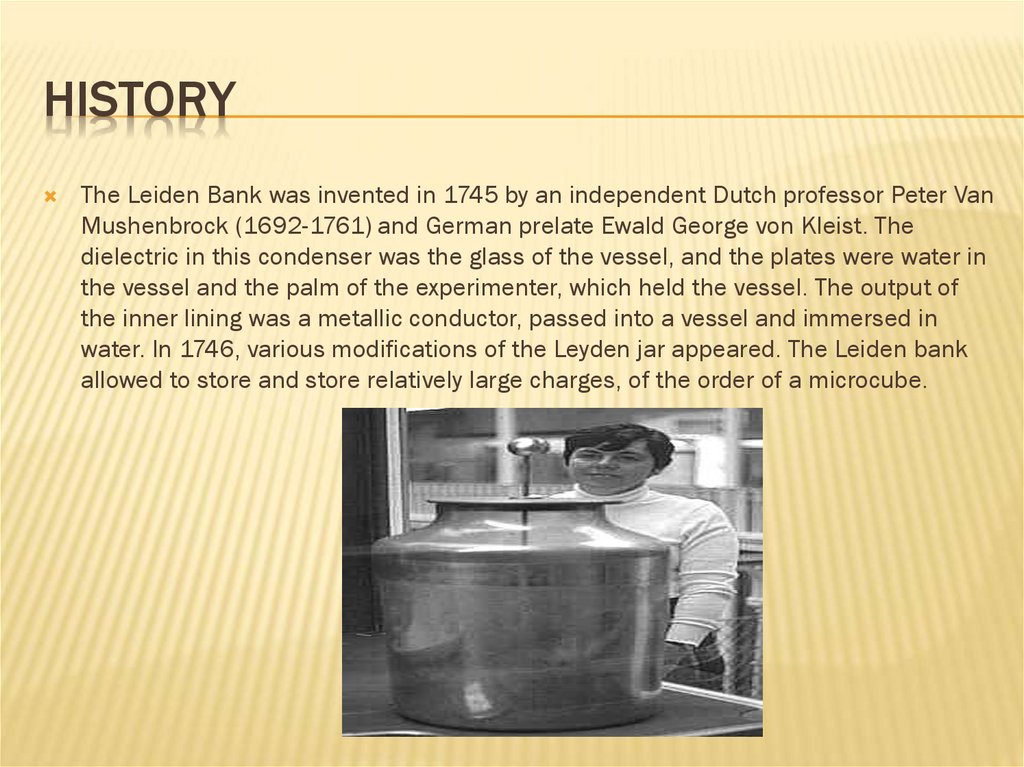








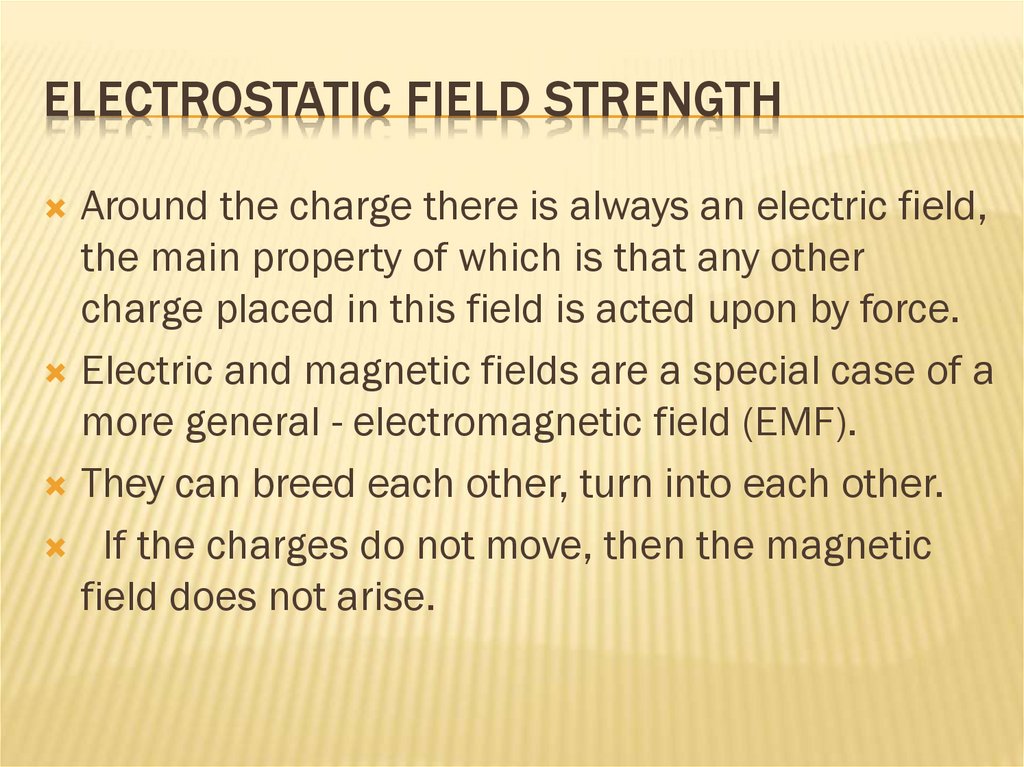
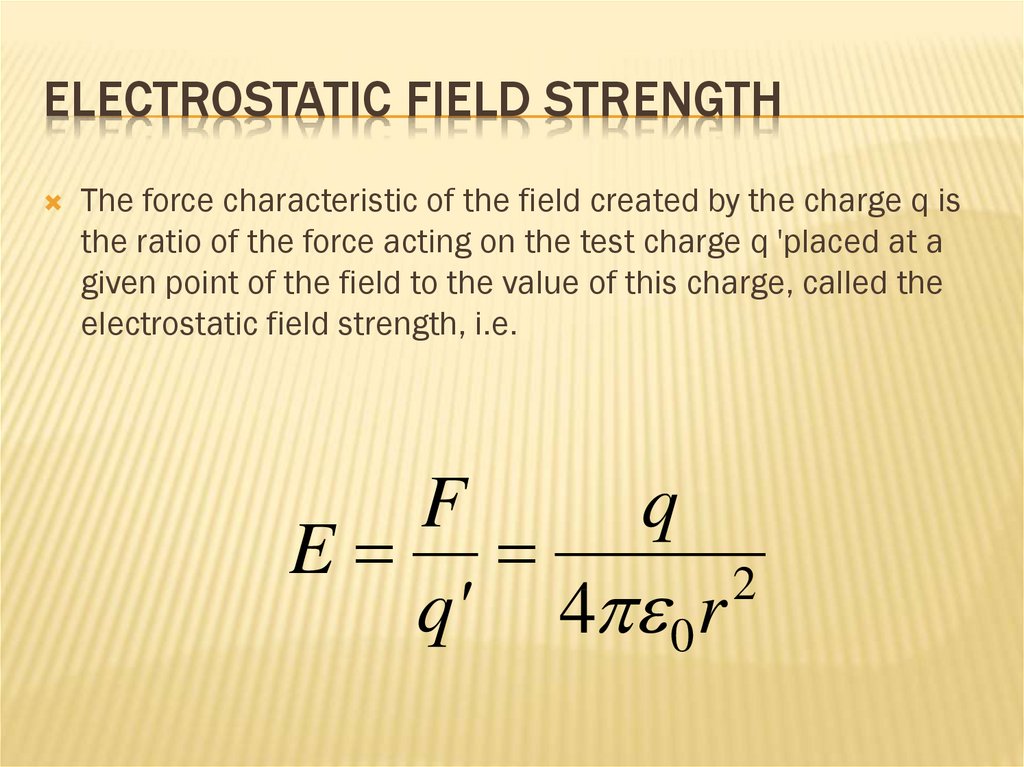


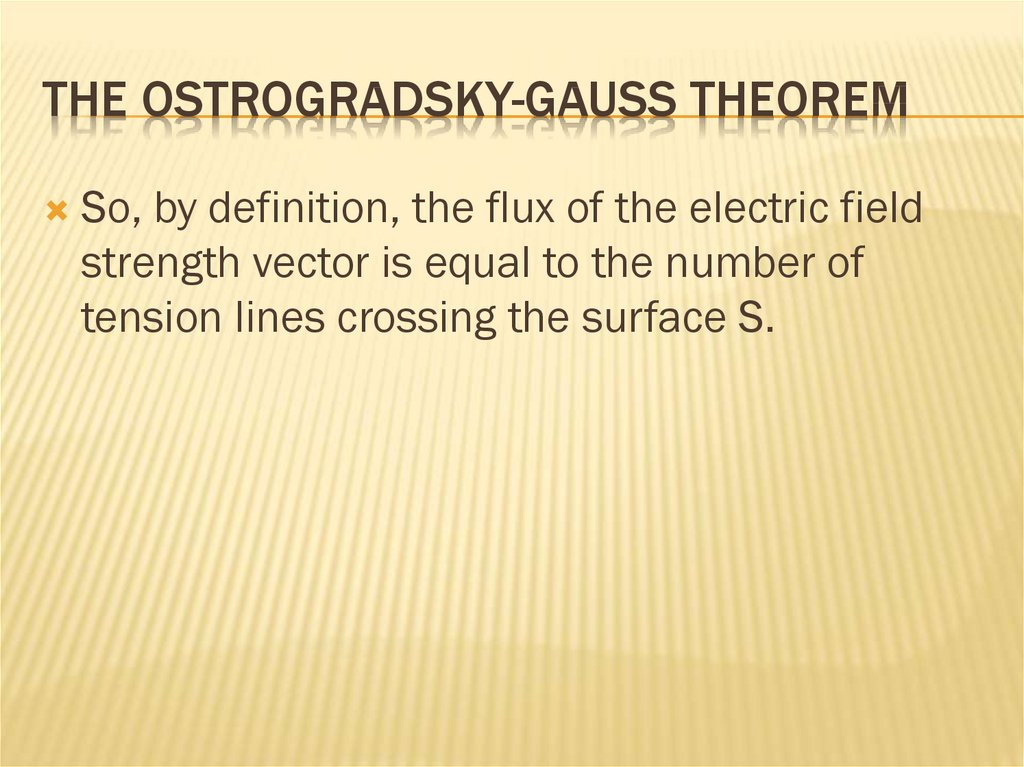






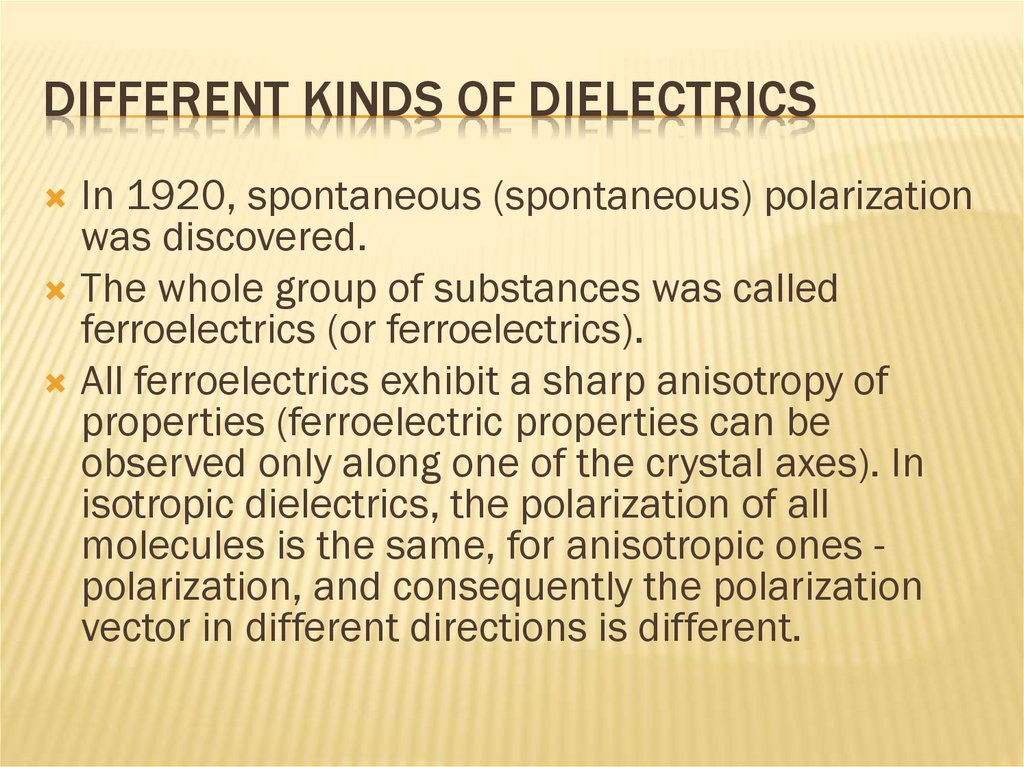






















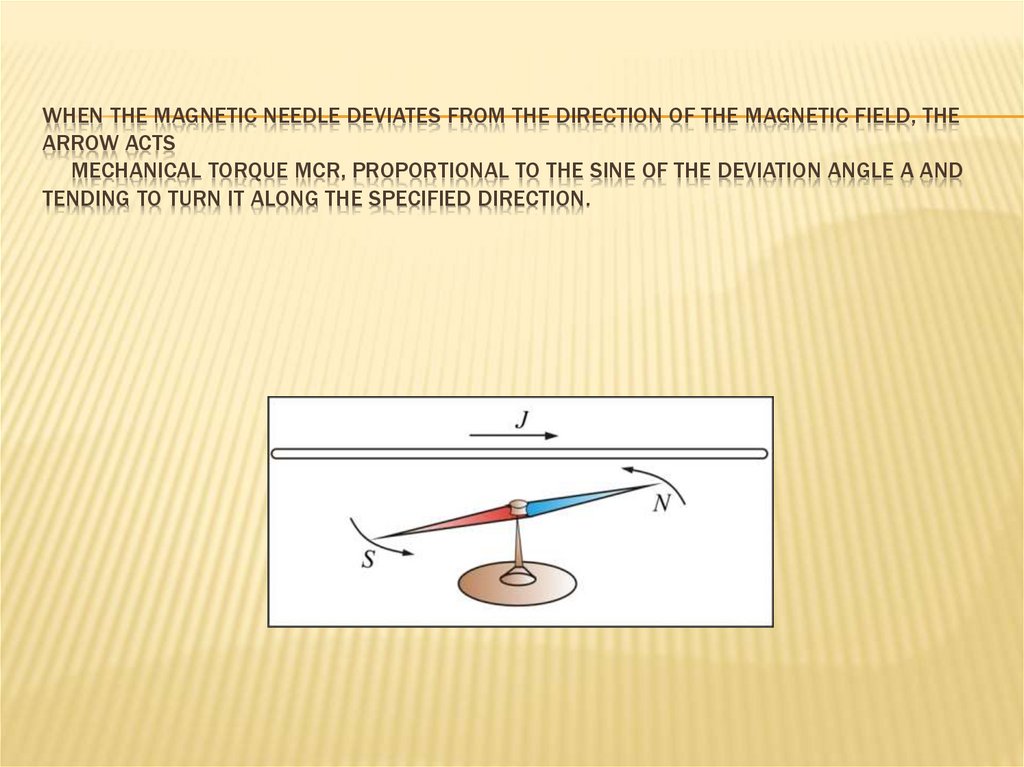

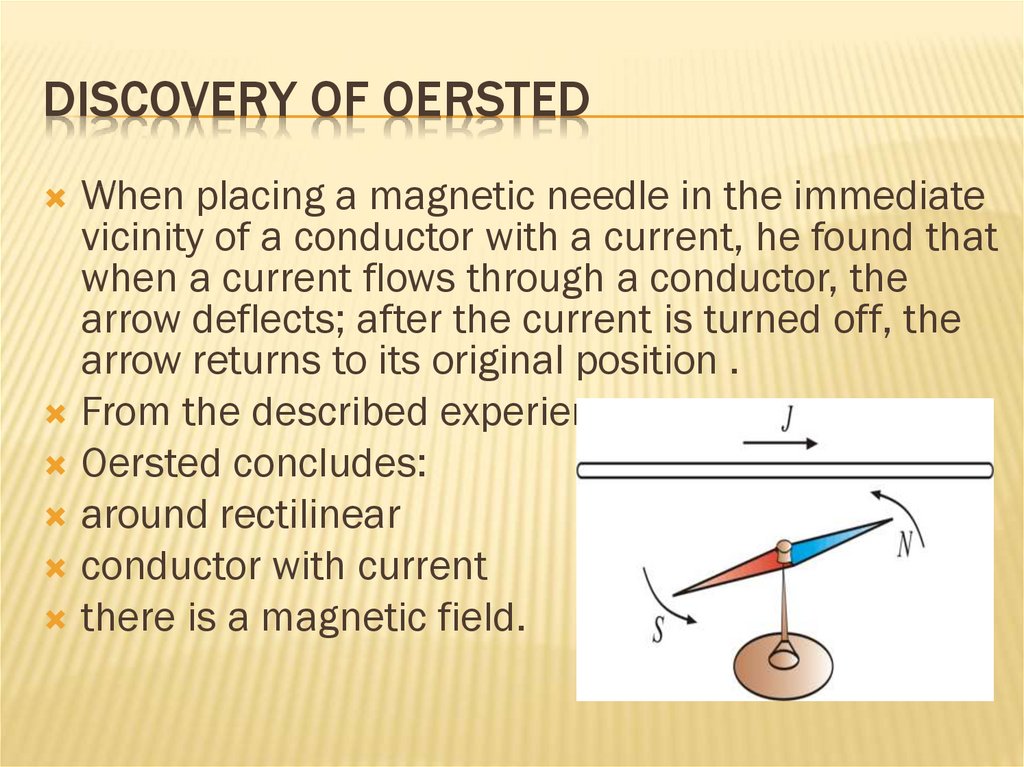
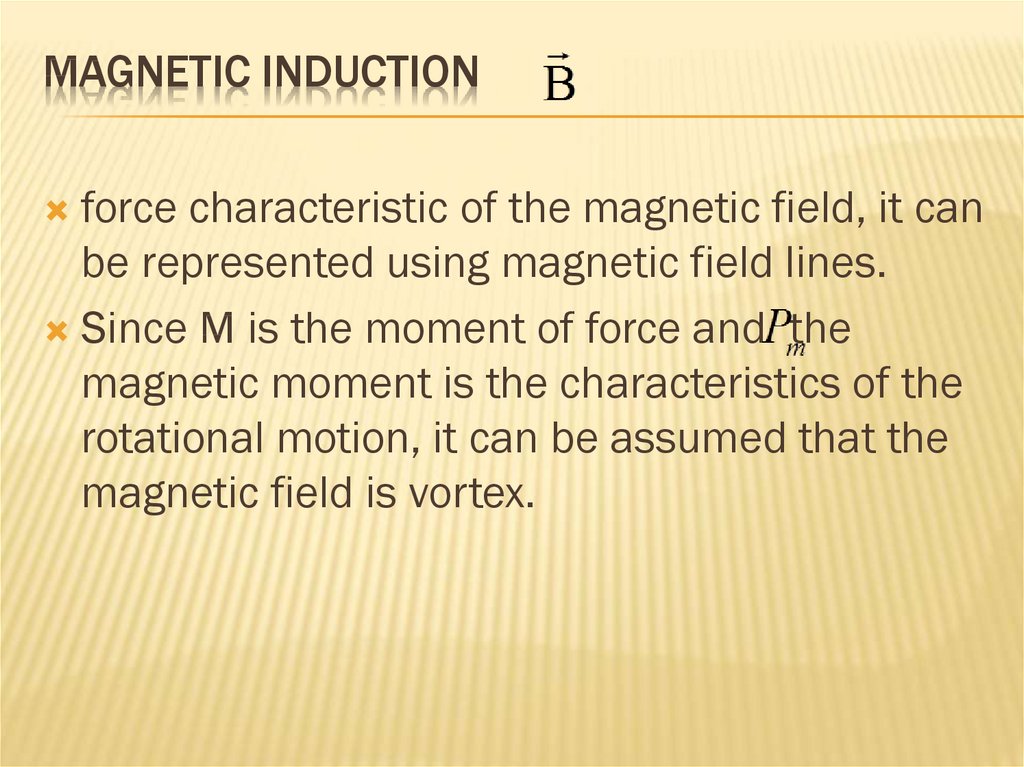





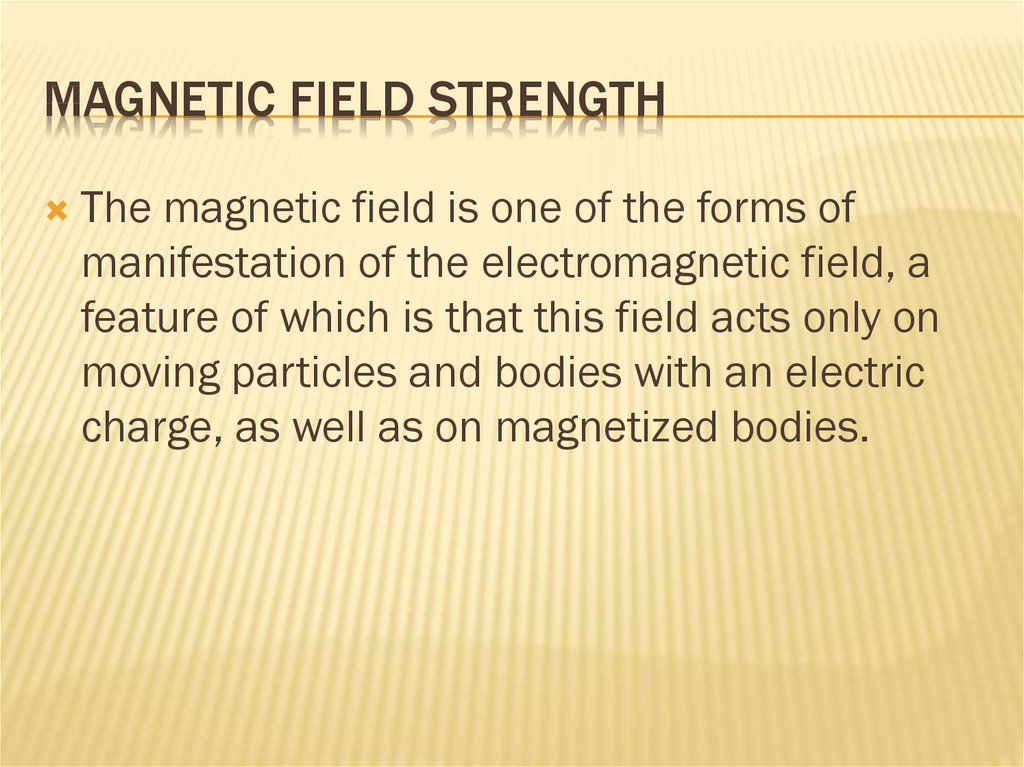











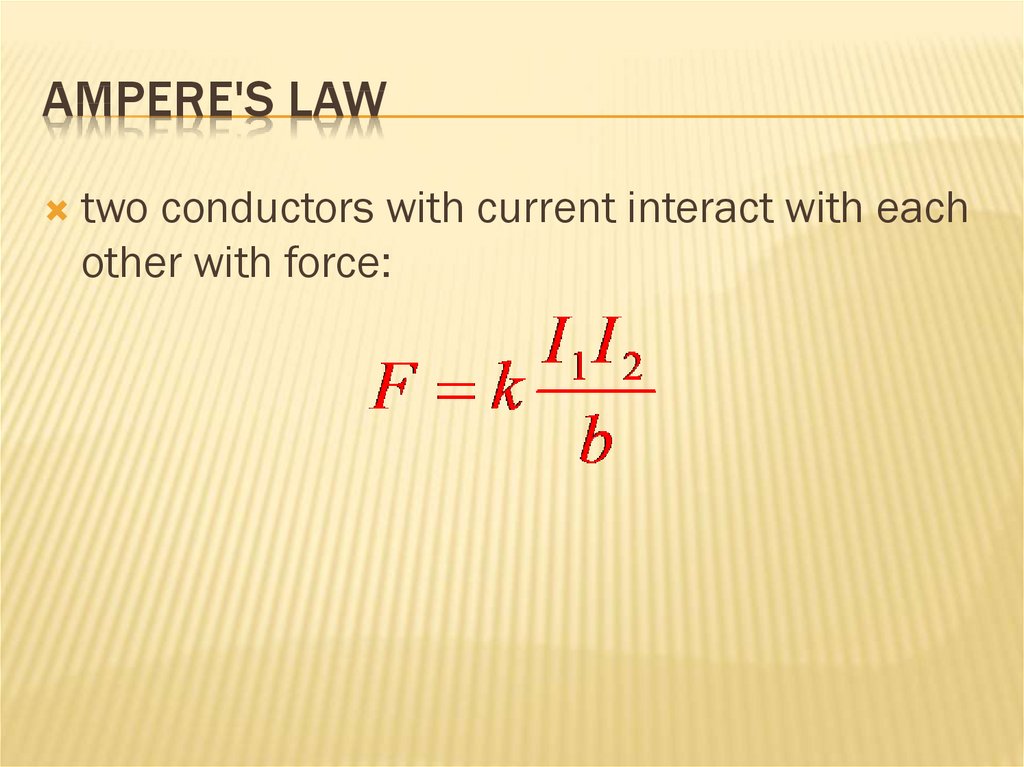





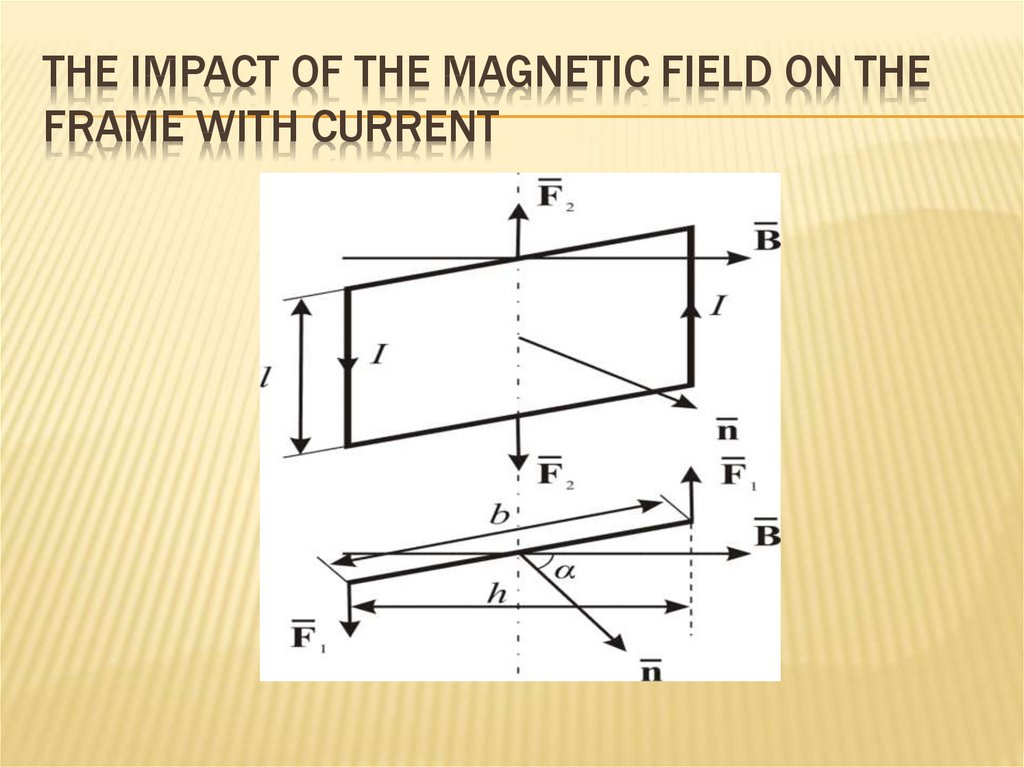




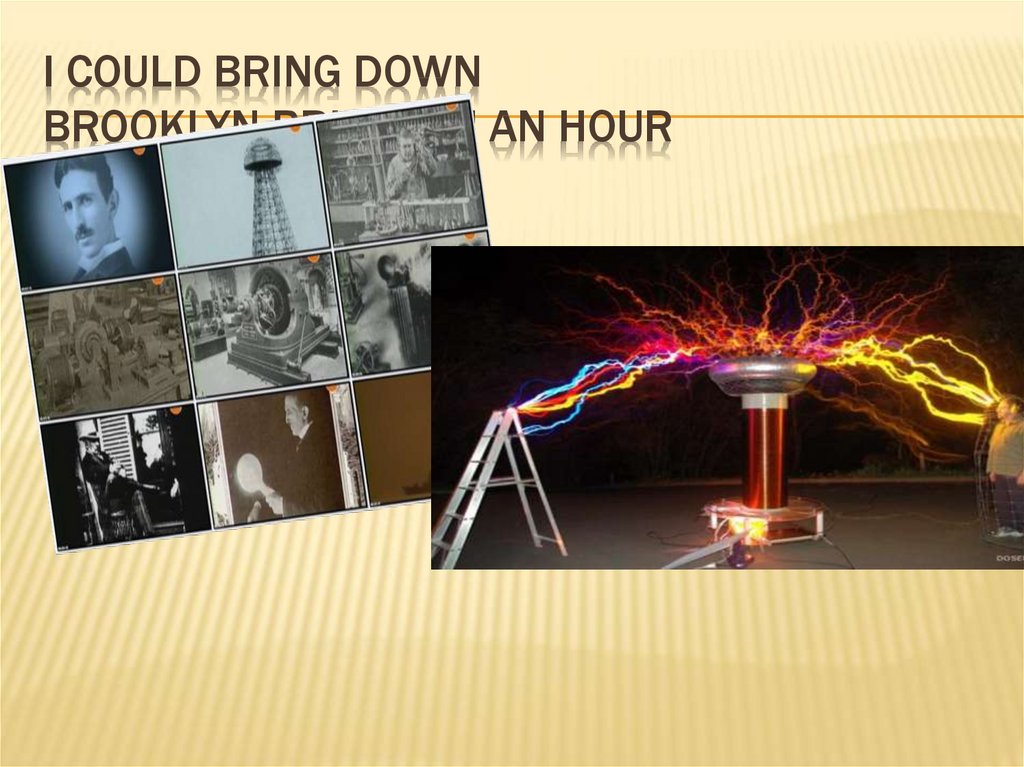



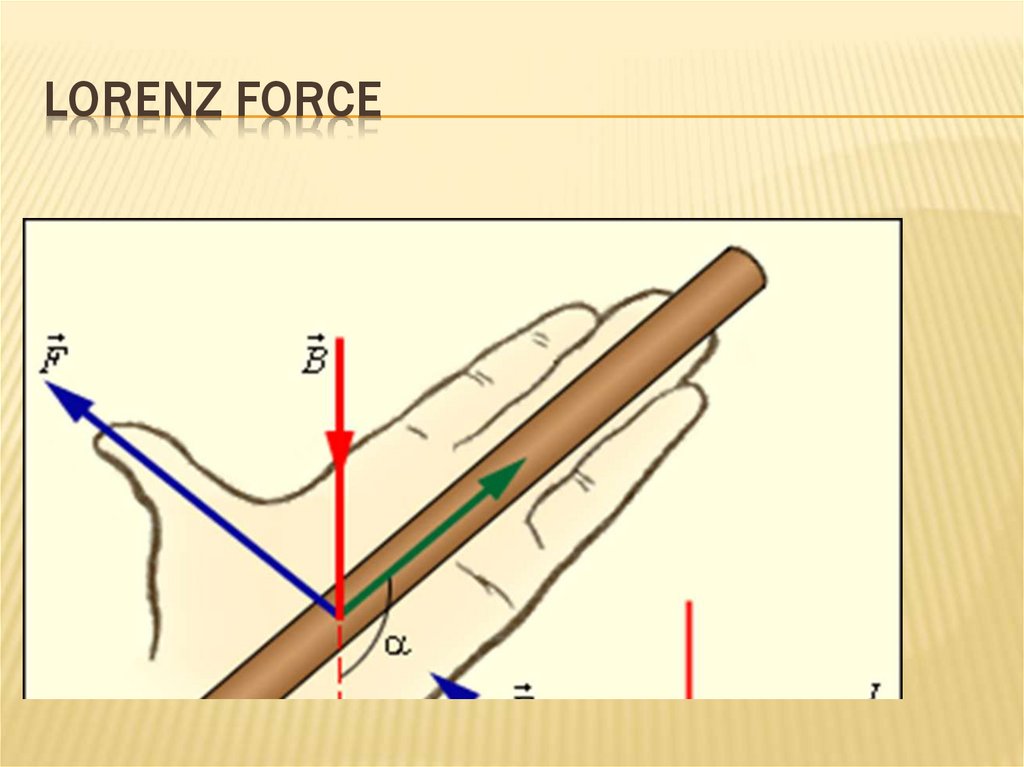
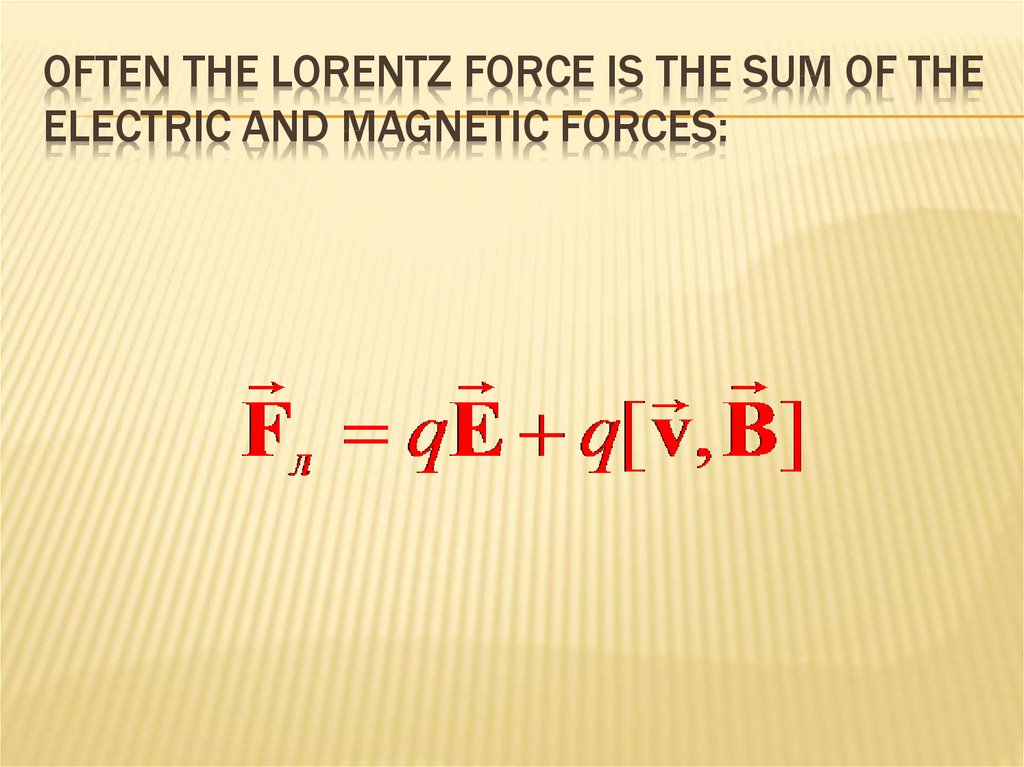

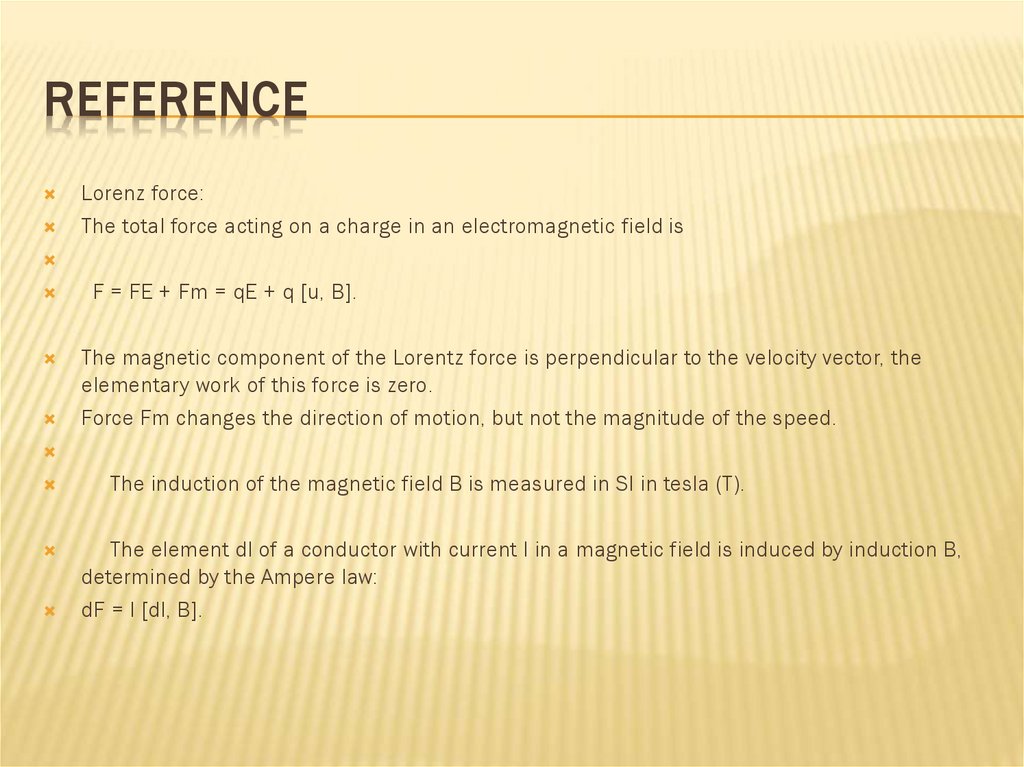

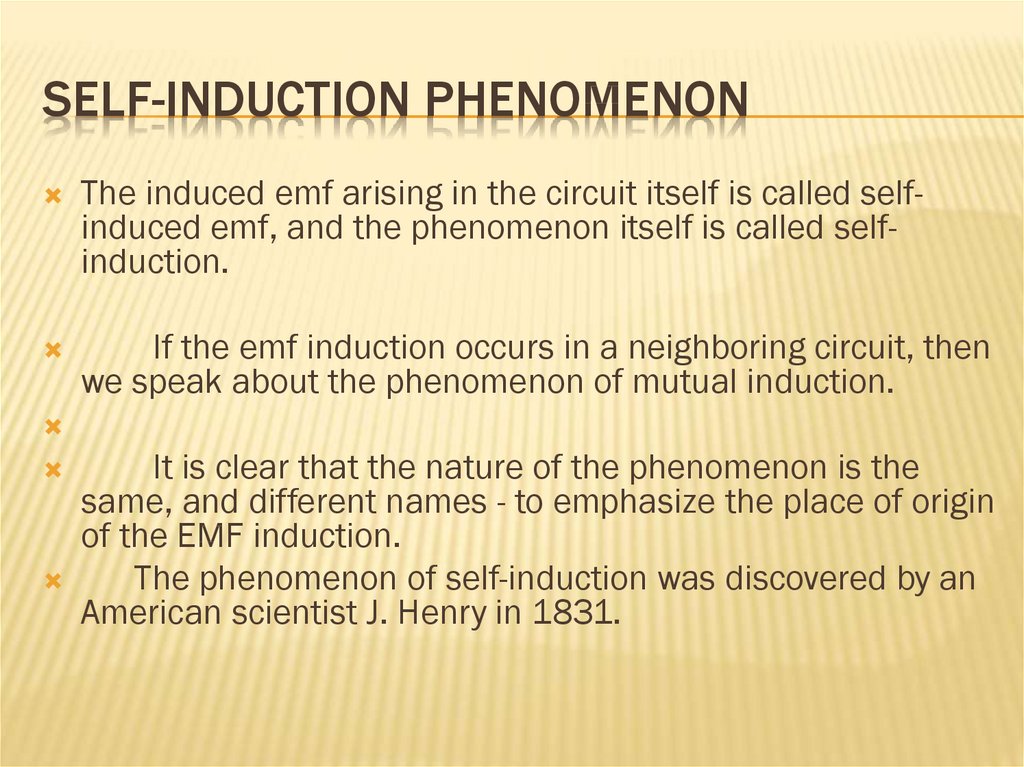




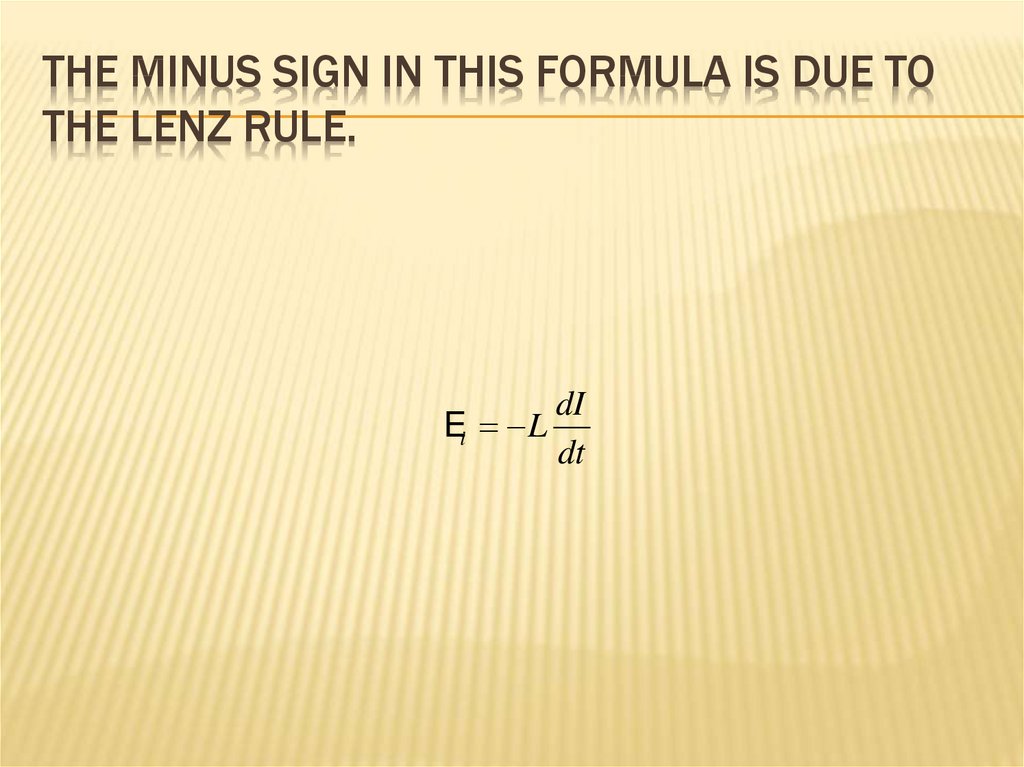

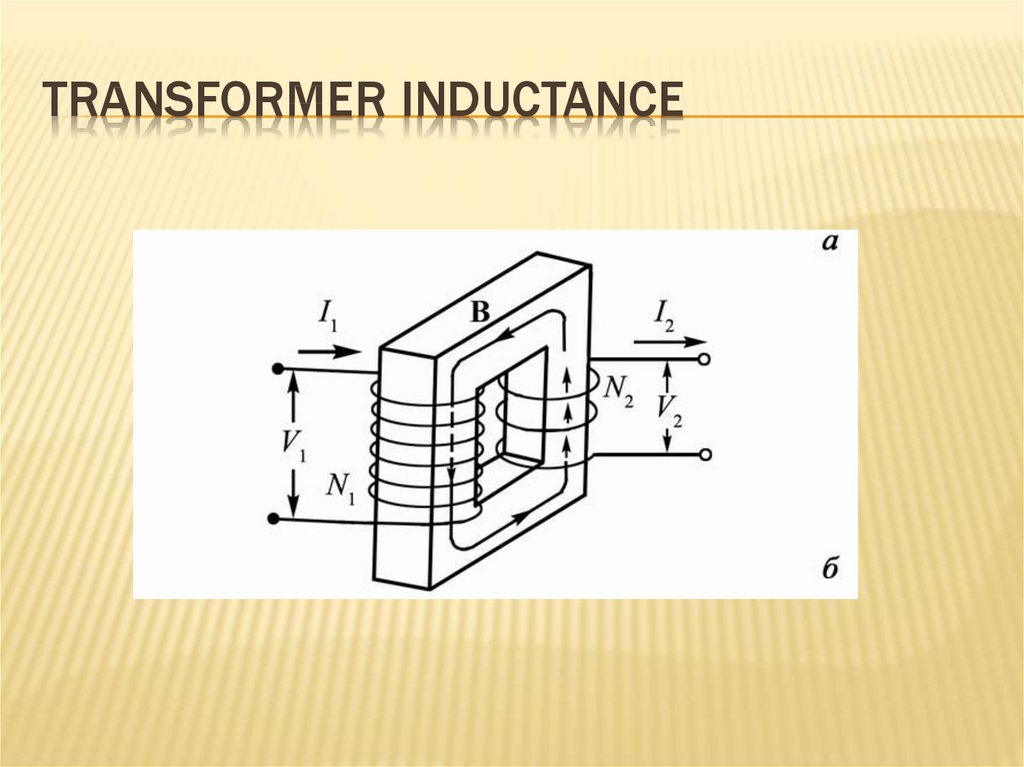







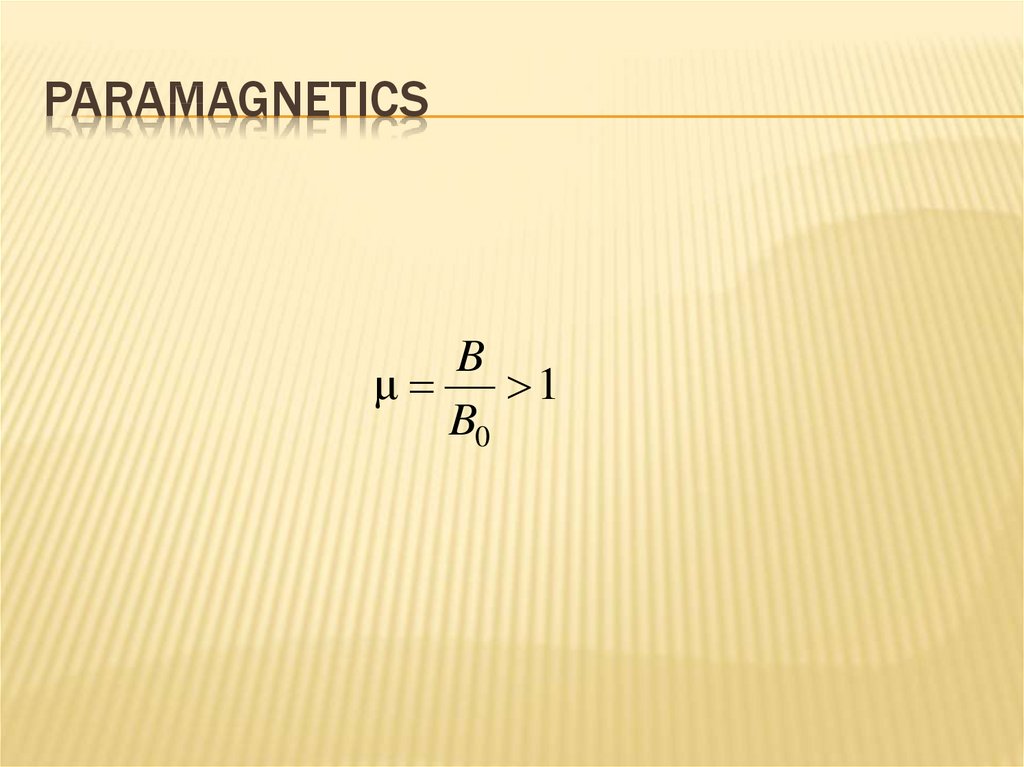

 mechanics
mechanics








